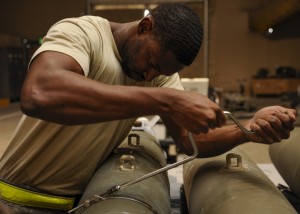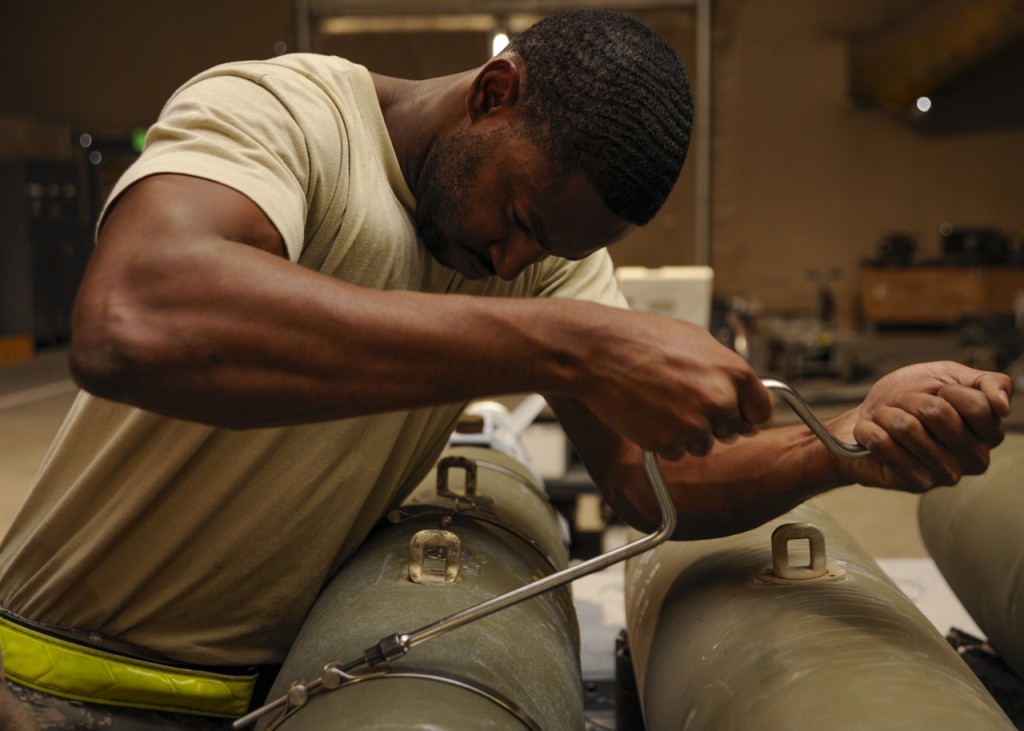
UNDISCLOSED LOCATION – When troops on the frontlines come in contact with enemy forces, the B-1B Lancer is called to deliver bombs with combat precision. Behind the scenes are 379th Expeditionary Maintenance Squadron ammo airmen here who build bombs with comparable precision to support combat operations.
“We provide safety for the guys on the ground with our guided bomb units,” said Senior Airman Jesse Bermudez, a 379th EMXS conventional maintenance crew member and a San Antonio native. “We assemble them, make sure they are delivered to the flightline and loaded up on planes ready to go.”
Ammo troops are responsible for building and maintaining several different types of munitions in support of the 9th Expeditionary Bomb Squadron. The type and amount of munitions needed for most missions is determined by a pre-selected assortment of bombs called the standard configuration load.
“The SCL is optimized so the ground commanders can call on the ‘B-one’ [B-1] to be there in a hurry and deliver with ‘good effects,’” said Senior Master Sgt. Kevin Buff, the 379th EMXS munitions systems superintendent and Riverdale, GA., native.
Typically eight or nine people can complete a bulk build, depending on the number bombs, Bermudez said. The builds can take several hours, but the majority of the work is in the preparation.
“The components have to be inspected to ensure they’re serviceable and ready to go before we can even think about putting it together,” Bermudez said. “One little mistake is the difference saving a guy’s life on the ground or going to a fallen warrior ceremony. So I believe it’s important.”
After the prep phase, the crews are able to begin production. From start to finish they follow their technical data, which tells them exactly how the bomb is to be assembled.
“We go through it [technical data] step-by-step from nose-to-fin,” Bermudez said, “From installing the fuses to installing the nose plug and the guiding set, which is the fin attached to the back of the bomb.”
Assembled munitions not used right away are stored in a staging area until the mission requires them. But like most quality products, the systems they build have a shelf-life. Once they’ve expired, they need to be taken apart, inspected and reassembled.
“Around here, we don’t plan on keeping them on the shelf too long,” said Bermudez. “But every six months, we have to do an AMSI [Assembled Munitions Serviceability Inspection] where we break apart the bomb and re-inspect all the munitions components to make sure it’s still serviceable and within the service life dates.”
Operational safety is also especially important while the ammo Airman are building, maintaining and inspecting the bombs, said 1st Lt. Igor Sachko.
“When dealing with explosives, it’s very crucial to maintain a culture of safety and compliance and do the job right every time,” said Sachko, the 379th EMXS munitions flight commander, who hails from Arlington, TX. “These are explosive assets and it can be very dangerous if any corners are cut or steps skipped.”
Bermudez added many people perceive handling explosives as the most dangerous part of building a bomb, but there are also several industrial hazards associated with the build including tripping hazards and other risks with not wearing proper personal protective equipment.
“It’s important to wear the proper PPE – gloves for hazardous chemicals and eye protection for any pieces protruding out of the bomb,” said Bermudez.
The 379th EMXS conventional maintenance section here is deployed from the Dyess Air Force Base, TX, providing quality munitions to support deployed troops on the ground throughout the U.S. Air Forces Central Command area of responsibility.
“We may not be on the front lines building bombs, but the bombs we build are saving the lives of our brothers and sisters on the ground, Buff said. “They need us to be technically accurate because we don’t have a second chance when the time comes.”
Read more: http://www.dvidshub.net/news/113266/building-bombs-saving-lives#.Ui5WxeD3M20#ixzz2eRN5oURv









